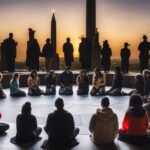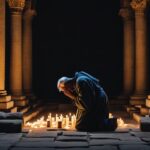Prayer revival history is a transformative journey of faith that has sparked powerful movements throughout time. Understanding the timeline of prayer revivals, the key events and figures, and the impact they had on the church and society can inspire and guide us on our own spiritual journey. Let’s explore the fascinating history of prayer revival.
Key Takeaways:
- Prayer revival history is a transformative journey of faith.
- Revivals have had a profound impact on the church and society.
- Understanding the history of prayer revival can inspire and guide us on our own spiritual journey.
- The timeline of prayer revivals includes significant events and figures.
- Exploring prayer revival history can deepen our understanding of the power of prayer.
The Ten Greatest Revivals Ever
Throughout history, prayer revivals have left an indelible mark on the spiritual and social fabric of societies. “The Ten Greatest Revivals Ever” by Elmer L. Towns and Douglas Porter highlights some of the most impactful prayer revivals in history. These revivals have stirred the hearts and souls of people, transforming individuals, communities, and nations.
“Revivals are not just an event, but a divine intervention that ignites a passion for God and a hunger for spiritual awakening. They bring about renewal, revival, and lasting transformation.”
Let’s explore these ten remarkable revivals that have shaped the course of prayer revival history:
- The 1904 Revival beginning in Wales
- The First Great Awakening
- The Second Great Awakening
- The General Awakening
- The Layman’s Prayer Revival
- The World War II Revival
- The Baby Boomer Revival
- The Pre-Reformation Revival
- The Protestant Reformation
- Pentecost
Each of these revivals had its unique characteristics and impact on the spiritual landscape of the time. Let’s delve deeper into the stories, events, and key figures behind these powerful movements.
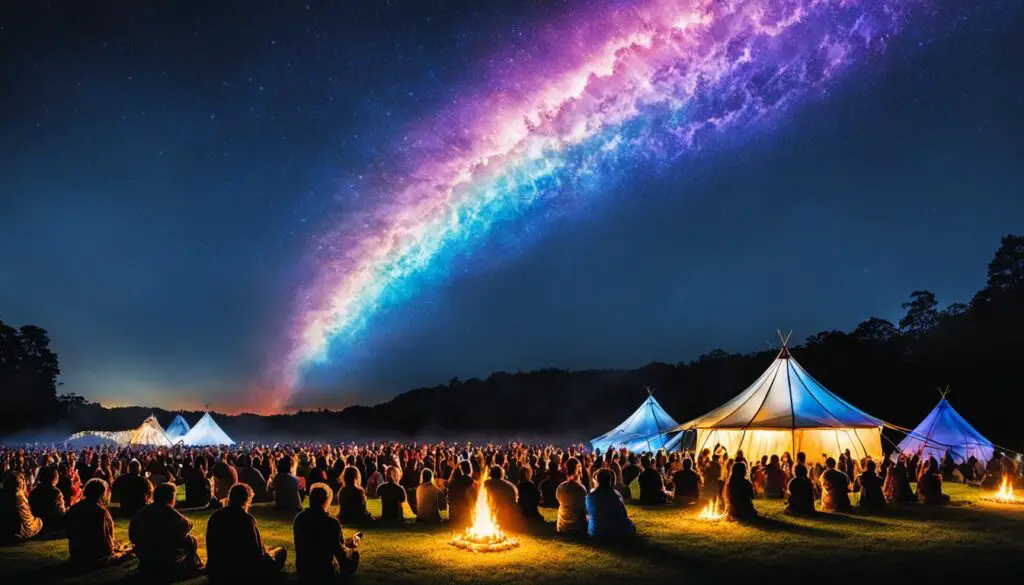
As we explore the rich tapestry of prayer revival history, we are reminded of the profound transformations that occur when individuals and communities turn to God in wholehearted and fervent prayer. From the Welsh revival to the Pentecostal outpouring and the birth of new denominations during the Protestant Reformation, these revivals serve as a testament to the enduring power of prayer and the transformative work of the Holy Spirit.
The 1904 Revival, Beginning in Wales
In 1904, a remarkable prayer revival, known as the Welsh revival, swept across the country of Wales, transforming lives and communities. This revival, sparked by the fervent prayers and spiritual hunger of a young man named Evan Roberts, had a profound impact on the church and society as a whole. Through Roberts’ passionate dedication to prayer, a movement of spiritual awakening was ignited, leading to numerous conversions and a renewed commitment to living out the gospel.
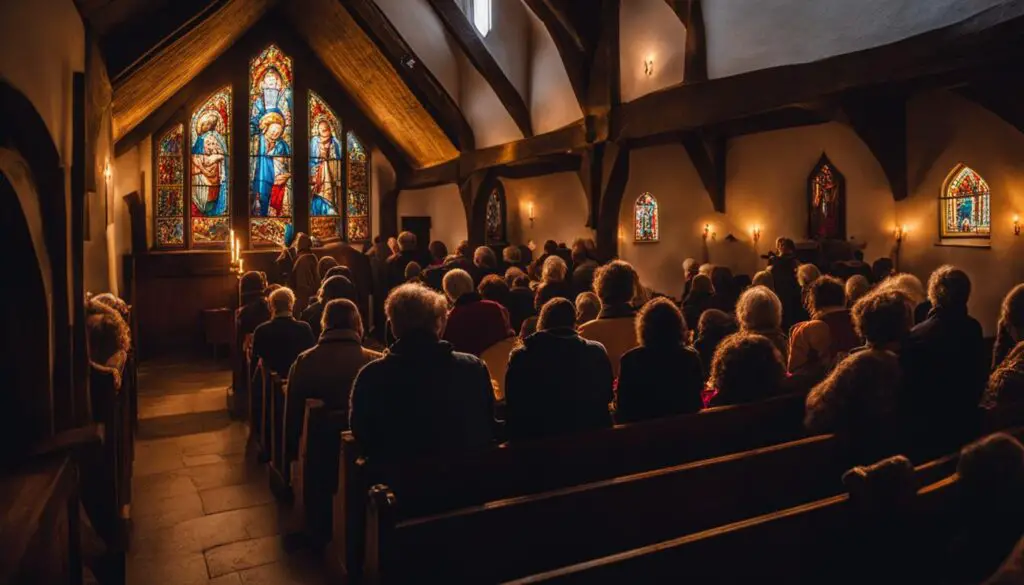
During the Welsh revival, prayer meetings were held in churches, homes, and even coal mines, drawing thousands of people seeking God’s presence and revival. Roberts’ message of repentance and personal consecration struck a chord with many, stirring their hearts and leading to genuine transformations. The power of prayer and the Holy Spirit’s work during this revival were undeniable, as testimonies of healing, deliverance, and conviction spread throughout the nation.
“I want to see a spiritual awakening, the greatest revival in the history of Wales. The Holy Spirit has come upon me with such power, and I am astonished at the miracles, not of healing, but of grace.” – Evan Roberts
The Impact of the Welsh Revival
The Welsh revival had a lasting impact on both the church and society. It revitalized congregations, leading to increased participation in worship and fervent prayer. Churches that were once struggling experienced a renewed sense of purpose and spiritual vibrancy.
Furthermore, the Welsh revival brought about a significant moral transformation in the communities it touched. Crime rates decreased, alcohol consumption reduced, and the sanctity of family life was restored. The revival also reshaped the future of theological education, leading to an increase in the number of individuals seeking to serve God through ministry.
Key Prayer Revival Events of the Welsh Revival
| Event | Date |
|---|---|
| Prayer Meeting in Blaenannerch | September 29, 1904 |
| Start of Evan Roberts’ Ministry | October 31, 1904 |
| Meeting at Moriah Chapel, Loughor | November 26, 1904 |
The 1904 Revival in Wales serves as a powerful testament to the impact of prayer and the transformative work of the Holy Spirit. It remains an inspiration to believers today, reminding us of the power of revival and the importance of fervent, persistent prayer. May we continue to seek God’s presence and long for a revival that will transform our lives, our churches, and our communities.
The First Great Awakening, 1727-50
The First Great Awakening, spanning from 1727 to 1750, marked a significant era of spiritual renewal and revival in colonial America. This monumental prayer revival was characterized by the impactful preaching of two influential figures: George Whitefield and Jonathan Edwards. Their fervent messages centered around the necessity of personal conversion and the vibrant expression of faith.
“The great work of God, which is now going on in the land, doubtless is the revival of religion and the advancement of Christ’s kingdom.” – George Whitefield
George Whitefield, an English Anglican cleric and evangelist, became known for his powerful sermons that stirred the hearts of countless individuals. He traveled extensively, proclaiming the Gospel with passion and conviction, drawing large crowds wherever he went. Whitefield’s preaching during the First Great Awakening played a pivotal role in sparking spiritual awakening and igniting a passion for revival among the masses.
“Unconverted men walk over the pit of hell on a rotten covering.” – Jonathan Edwards
Jonathan Edwards, a Congregationalist preacher, delivered one of the most famous sermons of the First Great Awakening, titled “Sinners in the Hands of an Angry God.” His vivid portrayal of God’s wrath and the urgent need for repentance led many to a profound sense of conviction and ultimately conversion. Edwards’ steadfast commitment to preaching the Gospel and his influential writings made him a key figure in this transformative prayer revival.
The First Great Awakening had a far-reaching impact on colonial American society. It sparked a wave of religious fervor, leading to the growth of new denominations and the establishment of vibrant local churches. This revival also inspired significant social reform movements, including the fight against slavery and the advancement of women’s rights.

| Revival Events | Key Figures |
|---|---|
| The Great Awakening | George Whitefield, Jonathan Edwards |
| Religious fervor | Revival of new denominations |
| Social reform | Abolition, women’s rights |
The Second Great Awakening, 1780-1810
The Second Great Awakening, spanning from 1780 to 1810, was a transformative prayer revival that ignited a spiritual fervor across America. This revival was characterized by large-scale camp meetings and revivals, including the renowned Cane Ridge Revival in Kentucky.
The Cane Ridge Revival, held in 1801, was a remarkable gathering that drew thousands of people from different backgrounds and denominations. It was a powerful expression of worship, prayer, and preaching that left a lasting impact on all who attended. The revivalist fervor of Cane Ridge spread far and wide, igniting a passion for personal piety, evangelism, and social reform.
During the Second Great Awakening, people’s hearts were stirred, leading to a renewed commitment to their faith and an outpouring of spiritual experiences. Camp meetings and revivals became central in fostering this awakening, as individuals from all walks of life came together to seek God’s presence and salvation. These events provided a platform for powerful sermons, heartfelt prayers, and enthusiastic expressions of worship.
“The genuine revivalist prays as fervently as he preaches, and in private as well as in public. He not only prays for the individuals committed to his charge, but struggles corporately with God, like Luther, Knox, and Whitefield in their great fields of revivals.”
The Second Great Awakening had a significant impact on American society, fueling movements for abolition, temperance, and women’s suffrage. The passion for personal piety and societal transformation led many believers to actively engage in social justice causes and advocate for the rights and dignity of all individuals.
The Second Great Awakening serves as a testament to the power of prayer and the transformative impact it can have on individuals, communities, and nations. It continues to inspire us today to seek God’s presence, to cultivate personal piety, and to work toward a more just and compassionate society.
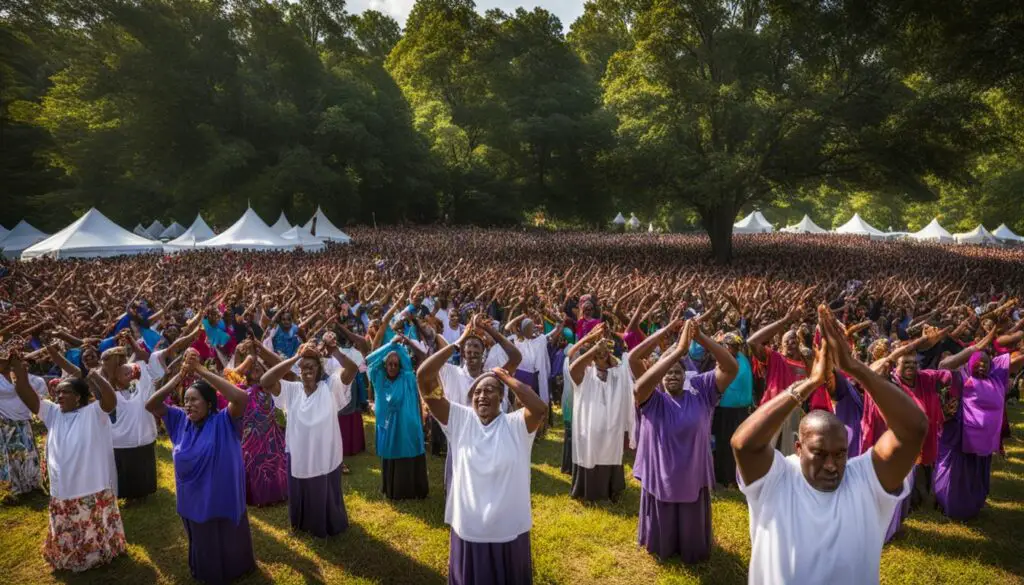
“The Second Great Awakening was a watershed moment in American religious history. Its spiritual fervor and the desire for revival continue to shape the American religious landscape to this day.”
The Layman’s Prayer Revival, 1857-61
The Layman’s Prayer Revival, also known as the Third Great Awakening, took place from 1857 to 1861. It was a period of profound spiritual awakening characterized by widespread prayer meetings and a renewed emphasis on personal holiness and corporate prayer.
One of the influential figures during this revival was Phoebe Palmer, an American evangelist and writer. Palmer’s teachings on the importance of prayer and the pursuit of holiness played a significant role in inspiring believers to seek God’s presence and power.
Another key figure in the Layman’s Prayer Revival was D.L. Moody, a renowned evangelist known for his dynamic preaching and passionate commitment to prayer. Moody’s impact on the revival can be seen in his tireless efforts to mobilize laypeople in prayer and evangelism, encouraging them to actively participate in spreading the gospel.
The Layman’s Prayer Revival had a profound impact on the church and society during this time. Thousands of people were converted to Christianity, and there was a renewed commitment to prayer and revival. The Fulton Street Prayer Meeting in New York City, which started in 1857, became one of the most significant prayer gatherings of the revival, providing a place for believers to come together and seek God’s face.
“In this revival, it has been preachers and laymen unitedly at work. No one part has taken the lead. This is one of the grand features of this ‘times of refreshing from the presence of the Lord.'” – D.L. Moody
The Layman’s Prayer Revival is a powerful testament to the transformative impact of prayer and the unity of believers. Its influence can still be felt today as we see the continued emphasis on prayer and revival in the church.
Prayer Revival Timeline
| Revival | Time Period |
|---|---|
| The First Great Awakening | 1727-1750 |
| The Second Great Awakening | 1780-1810 |
| The Layman’s Prayer Revival | 1857-1861 |
As we reflect on the Layman’s Prayer Revival, let us be inspired by the commitment of believers in the past and their passion for revival. May their example encourage us to seek God fervently in prayer, pursue personal holiness, and actively participate in the work of revival in our own time.
The World War II Revival, 1935-50
The World War II Revival, also known as the Healing Revival, took place from 1935 to 1950. This period of prayer revival was characterized by powerful evangelistic and healing crusades led by renowned figures such as Billy Graham and Duncan Campbell.
During this time, the world was grappling with the devastating effects of the war, and people turned to faith, seeking solace and divine intervention. The World War II Revival sparked a renewed interest in personal faith and the supernatural power of God. It was a beacon of hope amidst the darkness of those tumultuous years.
Billy Graham, the influential American evangelist, played a significant role in the revival. Through his dynamic preaching and soul-stirring messages, Graham captured the hearts and minds of thousands, leading them to surrender to Christ and experience spiritual transformation.
“The only hope for this troubled world is Jesus Christ. It’s through Him that we find forgiveness, peace, and the power to overcome,” proclaimed Billy Graham, inspiring countless individuals to turn to Christ for salvation.
“The world is not looking for more eloquent preachers or fine-spoken theologians. It is looking for men and women who can deliver a message that will break its heart and set it on fire. We need to see the power of God in our midst,”
Duncan Campbell, a Scottish revivalist, also made a profound impact during this revival period. He was instrumental in the Hebrides Revival, a powerful movement of prayer and spiritual awakening in Scotland. Campbell’s heartfelt prayers and passionate preaching stirred hearts to seek God fervently and experience His life-transforming presence.
The World War II Revival birthed numerous prayer revival events, where believers came together to intercede for their communities and nations. These gatherings were marked by fervent prayer, worship, and the proclamation of the Gospel. As people turned to God in prayer, lives were changed, healings were witnessed, and a wave of evangelism swept through the land.
“We must put prayer back into its primary place if we are to see God move in our midst,” emphasized Duncan Campbell, highlighting the indispensable role of prayer in the revival movement.
The World War II Revival had a widespread impact on the church, leading to numerous conversions, healings, and a renewed emphasis on evangelism. It served as a reminder of the power of prayer to bring about spiritual awakening and transformation.

As we reflect on this remarkable period of revival, let us be inspired by the faith and fervor of those who sought God amidst the challenges of World War II. May their testimonies encourage us to seek a personal revival, cultivate a fervent prayer life, and be agents of transformation in our own communities.
The Baby Boomer Revival, 1965-71
The Baby Boomer Revival, also known as the Jesus Movement, took place from 1965 to 1971. It was a time of radical transformation and spiritual awakening among young people, known as the Jesus People. This revival sparked a wave of fervent faith and passionate devotion to Jesus Christ.
The Baby Boomer Revival saw an emphasis on personal conversion experiences and a deep desire for genuine encounters with God. The Jesus People, often disillusioned with traditional church structures, sought to live out their faith in an authentic and radical way.
During this time, numerous prayer revival events unfolded, igniting the hearts of young believers. One of the most notable events was the Prairie Revival, which took place in the heartland of America. It brought together thousands of young people in a powerful display of worship, prayer, and seeking God’s presence.
Another significant prayer revival event during the Baby Boomer Revival was the spiritual awakening at Asbury College. In 1970, students gathered for a chapel service that turned into a powerful prayer meeting lasting for days. The Holy Spirit moved mightily, leading to repentance, reconciliation, and an outpouring of God’s grace.
Key Events of the Baby Boomer Revival:
| Event | Description |
|---|---|
| The Jesus People | Young people experiencing radical conversions and a passionate pursuit of Jesus Christ. |
| Prairie Revival | A gathering of thousands of young believers for worship, prayer, and encountering God’s presence. |
| Asbury College Spiritual Awakening | A powerful prayer meeting at Asbury College, resulting in repentance, reconciliation, and a divine outpouring. |
The Baby Boomer Revival left a lasting impact on the church and society. It revitalized the faith of a generation, renewing their commitment to evangelism, social justice, and living out the teachings of Jesus. The legacy of this revival continues to inspire believers to seek a genuine, radical relationship with God.
The Pre-Reformation Revival, 1300-1500
The Pre-Reformation Revival, spanning from 1300 to 1500, was a significant period of prayer revival that laid the groundwork for the Protestant Reformation. This revival was characterized by the efforts and influence of prominent figures such as the Lollards, John Wycliffe, Jan Hus, and Girolamo Savonarola. It emphasized the urgent need for reform within the church and a return to biblical truth.
The Pre-Reformation Revival had a lasting impact on the church, leading to important developments such as the translation of the Bible into vernacular languages and the questioning of religious authority. It marked a critical juncture in the history of the Christian faith, setting the stage for the profound changes that would follow during the Reformation era.
“Reformation begins in the closet. Prayer, humility, and spiritual fervor precede the emergence of powerful reformers.” – John Bibler
The Lollards: Champions of Reform
The Lollards were a group of English Protestants who played a significant role in the Pre-Reformation Revival. Led by John Wycliffe, they challenged the religious establishment and advocated for reforms within the church. Their passionate pursuit of truth and their commitment to translating the Bible into the English language laid a foundation for the Reformation that would later sweep across Europe.
John Wycliffe: The Morning Star of the Reformation
John Wycliffe, often referred to as the “Morning Star of the Reformation,” was a key figure during the Pre-Reformation Revival. He fiercely advocated for the translation of the Bible into English, believing that every individual should have access to the Word of God. Wycliffe’s efforts to make the Scriptures accessible to the common people laid the groundwork for the religious reforms that would follow in the centuries to come.
Jan Hus: The Bohemian Reformer
Jan Hus, a Czech reformer, made significant contributions to the Pre-Reformation Revival. He championed the ideas of John Wycliffe, translating his works into the Czech language and spreading his teachings throughout Bohemia. Hus’s boldness in challenging the corrupt practices of the church and his commitment to the authority of Scripture inspired a generation of reformers and set the stage for the events of the Protestant Reformation.
Girolamo Savonarola: A Voice of Reform in Florence
Girolamo Savonarola, an Italian Dominican friar, emerged as a prominent figure during the Pre-Reformation Revival. His powerful preaching and fervent call for moral and religious reform captivated the city of Florence. Savonarola condemned the corruption and immorality of the church and called for a return to genuine faith and devotion. His influence extended beyond his lifetime, shaping the trajectory of the Reformation and inspiring future reformers.
The Pre-Reformation Revival paved the way for the transformative changes that would later emerge during the Protestant Reformation. The revival’s emphasis on the need for reform, the translation of the Bible, and the questioning of traditional religious authority laid a foundation for the profound spiritual and theological shifts that reshaped the course of Christianity. The impact of the Pre-Reformation Revival can still be felt today, reminding us of the power of prayer and the pursuit of truth in bringing about transformative revival.
Conclusion
The history of prayer revival is a remarkable testament to the transformative power of faith. From the influential 1904 Revival in Wales to the dynamic Baby Boomer Revival, these prayer movements have left an indelible mark on individuals and entire societies. They have ignited a renewed passion for God and His kingdom, inspiring countless hearts to seek the transformative impact of prayer revival.
As we delve into the rich tapestry of prayer revival history, we are encouraged to reflect on the incredible journey of faith and devotion exhibited by those who came before us. Their stories serve as a beacon, leading us to dedicate ourselves to the pursuit of God and His purposes. The inspirational accounts of the past invite us to embrace prayer as a catalyst for personal and societal transformation.
Let the history of prayer revival be a constant reminder that our prayers have the power to shape destinies, renew hearts, and change the world. Through prayer, we can open ourselves to the transformative work of revival and invite the Holy Spirit to move mightily in our lives. As we learn from the past and unite in prayer, let us seek revival that will bring about lasting change in our churches, communities, and nations.
FAQ
What are some key prayer revivals in history?
Some key prayer revivals in history include the 1904 Revival in Wales, the First Great Awakening, the Second Great Awakening, the Layman’s Prayer Revival, the World War II Revival, the Baby Boomer Revival, the Pre-Reformation Revival, the Protestant Reformation, and the Pentecost.
What was the impact of the 1904 Revival in Wales?
The 1904 Revival, also known as the Welsh revival, had a transformative impact on the church in Wales. It led to thousands of conversions, powerful prayer meetings, and a renewed commitment to living out the gospel.
Who were some influential figures during the First Great Awakening?
Influential figures during the First Great Awakening include George Whitefield and Jonathan Edwards. They preached the need for personal conversion and living out a vibrant faith, which had a significant impact on colonial America.
What characterized the Second Great Awakening?
The Second Great Awakening was characterized by large-scale camp meetings and revivals, such as the famous Cane Ridge Revival in Kentucky. It sparked a renewed interest in personal piety, evangelism, and social reform.
What was the Layman’s Prayer Revival?
The Layman’s Prayer Revival, also known as the Third Great Awakening, was marked by widespread prayer meetings, like the Fulton Street Prayer Meeting in New York City. Figures like Phoebe Palmer and D.L. Moody played key roles in this revival, emphasizing personal holiness and corporate prayer.
What was the impact of the World War II Revival?
The World War II Revival, also known as the Healing Revival, led by figures like Billy Graham and Duncan Campbell, sparked a renewed interest in personal faith and the supernatural power of God. It resulted in numerous conversions, healings, and a renewed emphasis on evangelism.
What characterized the Baby Boomer Revival?
The Baby Boomer Revival, also known as the Jesus Movement, was characterized by radical conversion experiences among young people known as the Jesus People. It led to the formation of new Christian communities and a renewed passion for evangelism and social justice.
What happened during the Pre-Reformation Revival?
The Pre-Reformation Revival took place from 1300 to 1500 and laid the groundwork for the Protestant Reformation. Figures like the Lollards, John Wycliffe, Jan Hus, and Girolamo Savonarola emphasized the need for church reform and a return to biblical truth.
What can we learn from prayer revival history?
Prayer revival history is a testament to the power and faithfulness of God. It inspires us to seek God, dedicate ourselves to prayer, and be open to the transformative work of revival in our own lives. It also reminds us to pray for a revival that will bring about lasting change in our churches, communities, and nations.



